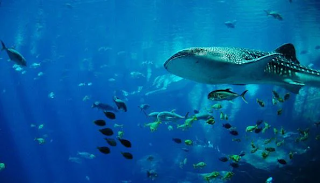496

Researchers from the Smithsonian Tropical Research Institute (STRI), the University of Panama and the Anderson Cabot Center for Ocean Life, Boston, have found the factors affecting the behaviour of whale sharks (Rhincodon typus) in the water bodies of the Panamanian Pacific. They used satellite tracking for this purpose.
Image Credits: Pixabay
Whale Sharks- The largest alive fish in the ocean
Whale sharks or Rhincodon typus are slow-moving fish species found in the tropical oceans of the world, such as the Maldives, Panama Pacific, Donsol Bay, etc. They feed on small fishes and plankton (small microscopic organisms) and travel long distances to live and reproduce.
Like other sharks, they take years to reach their maturity period to reproduce, which is one of the reasons for their population decline. However, human activities, such as fishing and marine transportation, cause disturbances in the water ecosystem, which leads to food loss for whale sharks. It is important to understand nature and predict the behaviour of whale sharks to prevent them from extinction.
What did the researchers find about whale sharks’ behaviour?
The researchers did satellite monitoring of the species. They found that the sharks reside in the coastal waters and ridges of the Panamanian Pacific to get sufficient food. Also, they were found migrating to Ecuador and Mexico along the northern and southern coasts in search of food.
“This species requires clear regional planning,” said Héctor Guzmán, an ecologist at STRI and study lead author. “Once the feeding and breeding aggregation areas are identified, some protection measures should be implemented. The newly announced marine protected area expansions across the region provide an interesting platform for large-scale conservation practices.”
Generally, they swim in the marine protected areas, but they also spend time in human interference water zones. This could put them in danger.
“The study shows how complex it is to protect whale sharks: tagged individuals visited 17 marine protected areas in 5 countries, but more than 77% of their time they were in areas without any protection,” said Catalina Gómez, study co-author and marine ecologist at the University of Panama.
These results show how endangered whale sharks are and the need for thinking beyond making conservation zones. This can include establishing marine corridors that surpass national borders to expand the area for their swimming. Examples; the Marine Conservation Corridor of the Eastern Tropical Pacific, Colombia’s Malpelo Island, etc.
How can we conserve whale sharks?
“A periodic tagging program should continue for two main reasons: first, we still don’t know where the species reproduces and tracking may lead us in the right direction,” said Guzmán. “Second, we know that they are moving across extensive areas. We have identified potential corridors or seaways, as well as aggregation areas, that require management attention and clear protection rules. Tracking will allow us to better identify those regional routes.”
The satellite tracking observations also showed the migratory patterns of whale sharks with respect to eddies (circular water currents).
“Eddies are recognized as potential feeding areas for migratory species or food epicentres in the oceans, so they can swim in those areas for a long time while foraging and feeding,” said Guzman. “However, eddies are dynamic systems and change constantly in speed or strength, size and location, even seasonally. These feeding areas are important for conservation, especially considering their dynamics and potential changes associated with climate change.
The research has been published in the journal Frontiers in Marine Science.
Follow us on Medium!

